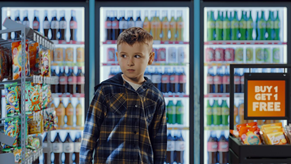Trust the meat thermometer

safefood reminds home cooks to ‘Trust the Meat Thermometer’ when cooking on the barbeque this summer
6th July 2022: With barbeque season well and truly here, safefood is encouraging home cooks to ‘trust the meat thermometer’ this summer and make sure they cook their BBQ meats like burgers, chicken and sausages to 75 degrees Celsius and enjoy the safest and tastiest food.
Four in ten home cooks (43%) have burned BBQ meats on the outside which were still raw in the centre
New research¹ from safefood has found that more than four in ten home cooks (43%) have burned BBQ meats on the outside but which was still raw in the centre, while a further 39% undercooked their food. Half of respondents (50%) said the hardest part of cooking on a barbeque was not burning the food while more than four in ten (45%) said knowing when the meat was thoroughly cooked was the hardest part. The most popular foods for cooking on a barbeque were burgers (66%), chicken (55%) and sausages (55%). These foods need to be cooked until piping hot, with no pink meat and the juices running clear to be safely cooked. Placing a meat thermometer in the thickest part of the meat adds that extra layer of safety and confidence to help home cooks get it right every time.
"Take your food off the heat, pop the thermometer in the thickest part of the meat and when it reaches 75 degrees Celsius, then it’s cooked and ready to eat. For meats like burgers, sausages, chicken, and kebabs, it is important that they are cooked until piping hot, with no pink meat and the juices running clear. Using a meat thermometer adds that extra layer of reassurance." - Dr Gary Kearney
Dr Gary Kearney, Interim Chief Executive, safefood said: “Cooking on a barbeque is one of those occasions we all look forward to – of those who cook on a barbeque, almost two in three (65%) do so during the summer or whenever the weather is good enough. Whether you’re an expert or novice BBQ cook, the one essential for your barbeque is a trusty meat thermometer.”
“Take your food off the heat, pop the thermometer in the thickest part of the meat and when it reaches 75 degrees Celsius, then it’s cooked and ready to eat. For meats like burgers, sausages, chicken, and kebabs, it is important that they are cooked until piping hot, with no pink meat and the juices running clear. Using a meat thermometer adds that extra layer of reassurance. If you’re cooking steaks, these can be cooked to preference.”
“Previous research² we carried out revealed that fewer than one in five people own a meat thermometer while only one in six actually used it”, continued Dr Linda Gordon from safefood. We also know that people perceive meat thermometers as being expensive or only used by expert cooks. However, you can purchase one for as little as €8-10 in home-retail and hardware stores and they are so easy to use and the most accurate way of checking for doneness. If you don’t have one, just follow the three checks of piping hot, no pink meat and the juices running clear.”
“‘I am delighted to be part of safefood’s ‘Trust the Meat Thermometer’ campaign. I think my love for barbequing is pretty clear but, having said that, I still am super cautious when it comes to safely preparing my meat-based meals – serving up food that isn’t cooked properly is every home cook’s worst nightmare!" - Guy Sinnott
Supporting the campaign, Guy Sinnott, home cook and creator of the Quarantine Cook-A-Long said “‘I am delighted to be part of safefood’s ‘Trust the Meat Thermometer’ campaign. I think my love for barbequing is pretty clear but, having said that, I still am super cautious when it comes to safely preparing my meat-based meals – serving up food that isn’t cooked properly is every home cook’s worst nightmare!
There are a few basic indicators to ensure that meat is cooked through; cut into it with a clean knife, check that it is piping hot all the way through, avoid pink meat and ensure juices run clear. My main piece of advice is to take the guesswork out of it and use a meat thermometer as it really does add that extra layer of reassurance.
It couldn’t be any easier, just pop the meat with the thermometer at the thickest part and when it reaches 75 degrees C you know you’re good to go!”
For more information visit www.safefood.net/news or follow safefood on Facebook, Twitter & Instagram.
Ends
To request an interview, please contact:
Wilson Hartnell
Heidi Morgan
[email protected]
Mob +353 (0)87 297 2046
safefood
Dermot Moriarty/Maeve Wrixon
Tel: +353 (0)86 381 1034 (Dermot) / +353 (0)87 334 1586 (Maeve)
[email protected]
References:
¹ Online survey of 1,000 adults aged 18+ on the island of Ireland. (Empathy Research; June 2022)
²“Assessment of the use of meat thermometers by consumers on the island of Ireland”; (safefood; Ulster University; & St. Angela’s College; 2021). The study comprised a literature review of meat thermometer ownership and usage; a survey of 1,052 adults on the island of Ireland; and six focus groups with 65 participants.
Editor’s Notes:
safefood’s 7 top tips for a safe barbeque
- Keep perishable foods like salads, coleslaw and quiche in your fridge until you are ready to serve them.
- Burgers, sausages and kebabs, pork and poultry must be cooked all the way through – take your food off the heat, pop the thermometer in the thickest part of the meat and when it reaches 75 degrees Celsius, then it’s cooked and ready to eat. Steaks can be served 'rare' as harmful bacteria are on the outside only (and not in the centre).
- If you like to marinate your meat, make sure any marinade used on raw meat is not then used as a sauce to coat vegetables or cooked meat as it will contain raw meat bacteria.
- If you choose to barbeque any frozen food, it must be firstly completely thawed on the bottom shelf of your fridge before you cook it.
- When handling raw meat and poultry, wash your hands thoroughly and frequently, most importantly before going on to prepare salads and other ready to eat foods.
- Once your meat is cooked thoroughly, make sure to keep cooked meat separate from raw meat and to use separate chopping boards, cooking utensils and plates. Harmful bacteria in raw meat, poultry and their juices can cross contaminate cooked food and lead to food poisoning, something your family won’t thank you for.
- If there are leftovers from your barbeque, allow the food to cool before refrigerating, however make sure to refrigerate food within two hours of cooking. Always remember with leftovers - if in doubt, throw it out.




